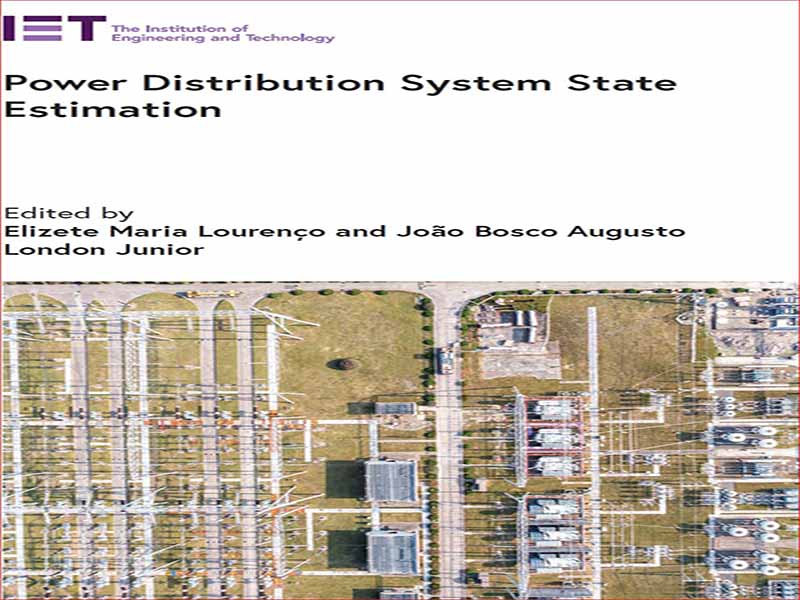- عنوان مجله: Power Distribution System State Estimation
- نویسنده: Elizete Maria Lourenço
- حوزه: َتوزیع برق
- سال انتشار: 2022
- تعداد صفحه: 387
- زبان اصلی: انگلیسی
- نوع فایل: pdf
- حجم فایل: 28.5 مگابایت
سیستم های قدرت الکتریکی در زمان حاضر دگرگونی های عظیمی را تجربه می کنند. منابع انرژی تجدیدپذیر جدید با رفتار متناوب و متصل به سیستم توسط اینورترها، اعم از متمرکز یا توزیع شده، نقش غالب در گسترش تولید را بر عهده می گیرند و چالش های جدیدی را برای ارسال و کنترل بهینه سیستم های به هم پیوسته ایجاد می کنند. فرآیند دیجیتالیسازی که با استقرار سیستمهای پردازش اطلاعات و ارتباطات پیچیده، همراه با دستگاههای ابزار دقیق و تله متری جدید معرفی شده است، امکانات جدیدی را برای نظارت و کنترل ارائه میدهد. همچنین، ویژگی های جدید بار معرفی شده توسط پاسخ تقاضا و برق رسانی حمل و نقل، فرصت های جدیدی را برای تطبیق بهتر تولید و مصرف باز کرده است. برآورد حالت از زمانی که در اوایل دهه 1970 معرفی شد، با تکامل سیستم های قدرت همراه بوده است. اهمیت آن به مدت طولانی به عنوان یک جزء اساسی از سیستم های مدیریت انرژی شناخته شده است. همانطور که سیستم قدرت تکامل می یابد، همچنین باید برای سازگاری با تحولات سیستم بهبود یابد. نقش تخمین حالت در ابتدا با هدف ردیابی تکامل “وضعیت ایستا” تغییر زمان آهسته ناشی از تغییرات بار و به دنبال آن تنظیمات مربوطه در تولید بود. در ابتدا به طور کامل به سیستم انتقال اختصاص داده شد، به ویژه برای جلوگیری از حوادث فاجعه بار در سیستم قدرت، مانند خاموشی سال 1965 که در منطقه شمال شرقی ایالات متحده رخ داد. این بر اساس اطلاعات به دست آمده در کنار سیستم انتقال توسط سیستم موسوم به SCADA، یک سیستم با تأخیر بالا تشکیل شده توسط واحدهای راه دور و کانال های مخابراتی اختصاصی، تحت نظارت یک مرکز کنترل که دارای سخت افزار اختصاصی و تخصصی است، بود. از روزهای اولیه تا آغاز این قرن، تغییرات اندکی در مفاهیم اساسی آن به جز تحول طبیعی در محاسبات و سختافزار مخابراتی و همچنین پیشرفتهای الگوریتمی صورت گرفته است. پیشرفتهای جدید در روشهای برآورد حالت در ادبیات در رابطه با ویژگیهای سیستم قدرت مدرن گزارش شده است. توسعه اصلی در استفاده از برآورد حالت در سیستم توزیع بوده است. این بخش سیستم قدرت بیشترین تأثیر را از پیشرفتهای جدید داشت، زیرا منطقهای است که بیشترین فناوریهای مدرن در آن پیادهسازی شده است. استقرار اصلی فناوری شبکه هوشمند و همچنین منابع انرژی پراکنده در بخش توزیع متمرکز شده و شرایط و ضرورت ردیابی دقیقتر شرایط عملیاتی این بخش از شبکه را ایجاد کرده است. اطلاعات جمع آوری شده توسط سنج های هوشمند و سایر حسگرهای نصب شده در سطح توزیع فرصت هایی را برای بهبود الگوریتم های تخمین وضعیت توزیع موجود و توسعه الگوریتم های کاملاً جدید باز کرده است. برخی از این پیشرفتها با نیازهای خاص سیستمهای توزیع مانند نیاز به مدلسازی سه فاز، ماهیت متفاوت شبکههای فشار قوی، متوسط و ضعیف و مهمتر از همه، عدم وجود افزونگی در اطلاعات بلادرنگ سروکار دارند. در سیستم انتقال، استفاده گسترده از واحدهای اندازهگیری فازور (PMU) استقرار سیستم نظارت، حفاظت و کنترل منطقه وسیع را با شرایط بسیار دقیق برای آگاهی موقعیتی سیستم، اما چالش اختلاط اندازهگیریها با قابلتوجه را ایجاد کرده است. تفاوت در نرخ نمونه گیری همچنین، نرخ نمونهبرداری بالای موجود در PMUها، فرصتی را برای توسعه الگوریتمهای تخمین حالت بسیار مؤثر که میتوانند تکامل زمانی حالتها را ترکیب کنند، ارائه میدهد که منجر به امکان تخمین رفتار دینامیکی سیستم قدرت میشود. همچنین، پیشرفتهای هوش مصنوعی، بهویژه روشهای تکیه ماشین، روشهای مبتنی بر دادهها را برای تخمین حالت معرفی کردهاند که در ابتدا برای فرآیند پیشفیلتر کردن اعمال میشد، اما با پتانسیل گسترش به سایر مراحل فرآیند تخمین حالت. آخرین، اما نه کماهمیت، پیشرفتها در محاسبات با کارایی بالا، تحقیق در تخمین حالت چند ناحیهای را وادار کرده است تا از محیط محاسباتی توزیعشده و موازی استفاده کند. این کتاب کمک مهمی به این دوره جدید تخمین وضعیت سیستم قدرت است. این یک بررسی کامل از چندین پیشرفت جدید در تئوری و عمل تخمین حالت ارائه میکند و پیشرفتهای جدیدی را پیشنهاد میکند که برخی از آنها هنوز در مراحل تحقیق هستند. تأکید اصلی کتاب بر مدلسازی و روشهای راهحل جایگزین برای برآورد وضعیت سیستم توزیع است. هر دو روش مرسوم و جدید پیشنهادی برای مدلسازی سه فاز و الگوریتمهای راهحل، و همچنین درمان نوع جدیدی از اطلاعات، مانند دادههای PMU و Smart Meter، به طور گسترده توضیح داده شدهاند.
Electrical power systems are experiencing huge transformations in present time. New renewable energy sources with intermittent behavior and connected to the system by inverters, both centralized or distributed, are assuming a predominant role in the generation expansion, creating new challenges for the optimal dispatch and control of the interconnected systems. The process of digitalization introduced by the deployment of sophisticated information processing and communication systems, associated with new instrumentation and telemetry devices, has been offering new possibilities for supervision and control. Also, new characteristics of the load introduced by demand response and transports electrification have opened up new opportunities to better match production and consumption. State estimation has been accompanying the evolution of power systems since it was introduced in the early 1970s. Its importance has long been recognized as a fundamental component of the energy management systems. As the power system evolutes, it also must be improved to accommodate the systems transformations. The role of state estimation was initially aimed to track the evolution of the slow time varying “static state” resulting from the variations in load followed by the corresponding adjustments in generation. It was initially totally dedicated to the transmission system, particularly oriented to avoid catastrophic events in the power system, like the 1965 blackout occurred in the northeastern region of the USA. It was based on information obtained alongside the transmission system by the socalled SCADA system, a high latency system formed by remote units and dedicated telecommunication channels, supervised from a control center running dedicated and specialized hardware. Since its early days up to the beginning of this century, little has changed in its basic concepts except for a natural evolution on computation and telecommunication hardware as well as algorithmic improvements. New developments in state estimation methods have been reported in the literature in relation to the modern power system features. A main development has been in the application of state estimation to the distribution system. This power system segment was the most impacted by the new developments as it is the area where most to the modern technologies has been implemented. The main deployment of the Smart Grid technology, as well of Distributed Energy Resources, has been concentrated in the distribution segment, creating the conditions and the necessity of a more accurate tracking of the operating conditions of this part of the grid. The information gathered by Smart Meters and other sensors installed in the distribution level has opened up opportunities to improve the existing distribution state estimation algorithms and the development of completely new ones. Some of these developments deal with particular requirements of the distribution systems like the need for three-phase modeling, the different nature of the high, medium, and low voltage grids, and most importantly, the lack of redundancy in the real time information. In the transmission system, the spread use of Phasor Measurement Units (PMU) has proportioned the establishment of the wide area monitoring, protection, and control system, with a much accurate condition for the system situational awareness but introducing the challenge of mixing measurements with significant difference in sampling rates. Also, the high sampling rate available in PMUs offers the opportunity to development of highly effective state estimation algorithms able to incorporate the temporal evolution of the states, leading to the possibility of estimation of the power system dynamic behavior. Also, developments of artificial intelligence, particularly machine leaning methods, have been introducing Data Driven Methods to state estimation, initially applied to the pre-filtering process, but with potential to be extended to other phases of the state estimation process. Last, but not least, developments in high-performance computing have induced the research in Multiarea State Estimation to take advantage of the distributed and parallel computing environment. This book represents an important contribution to this new era of power system state estimation. It presents a thorough review of several new developments in the state estimation theory and practice and proposes new developments, some of them still in the research stages. The main emphasis of the book is in modeling and alternative solution methods for distribution system state estimation. Both conventional and newly proposed approaches to three-phase modeling and solution algorithms, as well as the treatment of new kind of information, like PMU and Smart Meter data, are extensively described.
این کتاب را میتوانید از لینک زیر بصورت رایگان دانلود کنید:

































نظرات کاربران